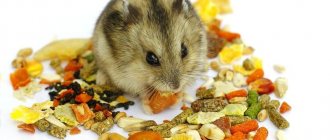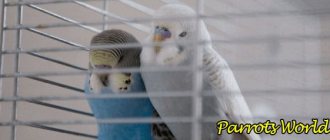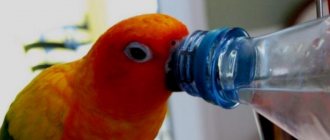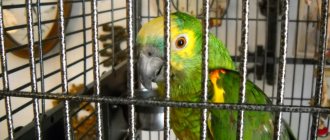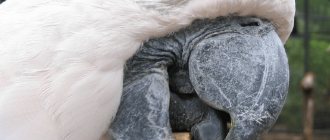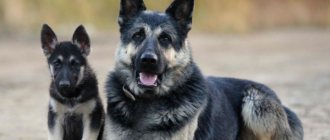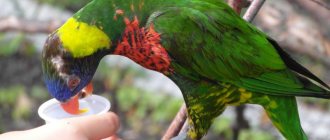In its natural habitat, that is, in Australia and on the islands adjacent to the mainland, the bird feeds on seeds, greens and fruits. The diet of birds at home is similar: grain feed and accompanying additives to replenish vitamins.
Let's find out what birds eat, what foods are of greatest interest to the parrot, and what budgerigars like.
Basic diet
Dear readers who dream of a wavy friend, this information will be useful for you. The basis of a parrot's diet is dry food, it is designed specifically for the needs of the bird.
There is a great variety of food for parrots. Starting from the cheapest Russian ones like “VAKA” and ending with Italian branded ones. They are sold in packages from 500 grams to 2 kg. In addition, you can always buy food in large quantities - from 10 to 25 kg.
What do budgies love and look for among grains? In first place are fruits and vegetables. When purchasing food, pay attention to its composition. There must be the treats mentioned earlier. This is what ideal food for parrots looks like:
- yellow, red and white millet;
- canary seed;
- shelled oats;
- apple;
- pear;
- cookie.
The more fruit in the diet, the better for the bird.
Grain mixtures
The most important part of a budgie's diet is cereal seeds. The seeds are very nutritious and contain sufficient calories. It is important that the birds eat the seeds of various cereal plants.
A basic grain mixture for feeding birds can be made up of 40% canary seed, 20% millet, 20% French millet and 20% oats.
Canary seed is the seed of the canary plant. This is a very good food for budgies; the grain mixture can contain up to 40%.
Millet is also a very popular food for parrots. It can be up to 50% in the grain mixture. Moreover, millet can be of different varieties - yellow, white, red. For budgies, it is best to take red millet, as it contains a lot of carotene - provitamin A.
Oats are another essential and nutritious food. It contains a large amount of protein. In winter, budgies are given more oats than in the summer months. Instead of oats, you can give peeled oats - oatmeal; it is well suited for feeding sick birds.
A good grain mixture should be clean, free of impurities, the grain in it should be shiny and have a pleasant smell. If the mixture has a musty smell, it is not suitable as feed.
You can make the grain mixture yourself, or you can purchase it at a specialty store. Such mixtures are formulated in accordance with the nutritional needs of birds and are well balanced.
Treats for parrots
What do budgies like, besides their main food? Birds will not refuse treats. Sticks consisting of grains, vegetables, fruits and honey can be purchased at any pet store. When purchasing, study the composition, it varies. Birds are offered cereal sticks with honey, fruit sticks with cinnamon, and mineral sticks with vegetables.
There are crackers for parrots, dried fruits and berries, all of which are sold in pet stores.
What is strictly forbidden to give?
Any fatty food is contraindicated for budgies: no sausages, sausages, etc. Salt and sugar should also be completely eliminated. The bird receives glucose in abundance through fruits. Any food from the human table can greatly harm a pet.
Budgerigars do not tolerate lactose well, so dairy products and cheese must be excluded.
Forbidden fruits:
- persimmon;
- potatoes in any form;
- avocado;
- papaya;
- mango.
Many breeders recommend placing twig food in the cage. It serves as an additional source of minerals and acts as a beak and paw cleaning tool. Branches of oak, lilac, bird cherry, pear and coniferous trees are dangerous for budgies.
Favorite vegetables
What to feed your budgie at home, besides the basic diet? These birds love vegetables, the list of them is quite extensive. This is what birds are allowed to do:
- raw zucchini;
- legumes together with pods;
- broccoli after treatment with boiling water;
- fresh corn on the cob;
- scalded white cabbage;
- fresh cucumbers;
- raw carrots;
- radish;
- sweet pepper with seeds;
- radish;
- turnip;
- all types of salad;
- raw beets;
- pumpkin;
- tomatoes;
- sorrel in small quantities;
- spinach.
Choosing an aviary
When you decide to have birds, you should take care of their comfortable stay. After all, birds like space and freedom, and because... the bird will live in a cage, then it needs to be provided with a large and durable aviary. Manufacturers have developed a large number of aviaries for birds. Square, round, metal, wood, twigs.
Size and shape
When choosing a cage, the owner should choose a huge, spacious, strong one, and one that is not dark in it. Pernatics are cowardly birds; to be comfortable, they need a lot of sunlight. By choosing a spacious enclosure for your pet, the owner will provide the pet with maximum freedom. And also if you have other pets, the wavy will not become prey for her.
Good materials from which an aviary can be made are:
- copper;
- tree;
- stainless steel.
Manufacturers often paint the enclosure with a zinc mixture. You shouldn’t buy these, because during peeling your pet can chew it off. This will have a bad effect on his health and lead to poisoning.
The wooden cage is popular among owners. It is harmless and will not cause chemical poisoning to the bird. However, a wooden enclosure should be chosen only from certain trees: willow, maple, birch, linden.
Arrangement
The owner cannot do it simply by purchasing a cage. It must contain the necessary accessories.
Aviary pallet
If the aviary has a grate at the bottom, then it should be removed, because the bird may injure its paws. Fillers are also not needed; you can lay down paper towels, but not newspaper, because the paint on it is toxic.
Perches
It is better to give preference to natural perches with bark. Having 2 or 3 perches is suitable; they should be of different diameters so that the pet’s paws do not get tired. Tree branches will also work.
Feeders
Manufacturers advise purchasing several feeders: for grain, porridge, fruit.
Drinking bowls
There are 2 types of drinking bowls: open and closed. The advantage of a closed drinking bowl is that debris cannot get into it, but this type of drinking bowl is inaccessible to birds. On the contrary, open drinking bowls are good in everything except one thing: garbage constantly gets into them. Therefore, it is worth hanging it in a place that is difficult to reach for garbage.
Sepia/mineral stone
Another necessary thing for a budgerigar is sepia. The bird sharpens its beak on it and receives calcium and minerals. But there is one important point: manufacturers suggest attaching a mineral pebble to a piece of iron, this is not suitable, because... the bird may be injured at the point of the beak. The stone should be tied to a string or attached with a clothespin. An important point: you cannot tie it with a thread, because the bird will clog its goiter.
Toys
To prevent your pet from getting bored, he should hang several toys. Just a little so that the chick can move freely around the cage.
Accommodation
The location of the enclosure depends on the construction of your house. The cage should be placed in a bright place with sunlight, because they are important for the pet's life. You cannot place it on a windowsill near a window. Due to its broad outlook, a bird may see something scary for it in the window, for example, a crow, and get scared. This can lead to stress or death of the bird, because they are very shy.
In winter, there is no need to place the enclosure near the battery. Due to the plumage, as well as the heat from the battery, the bird will be hot. Also, the enclosure should be at eye level of the owner, not on the floor, because walking by all family members will scare the pet. One side of the enclosure is near the wall so that the pet feels safe.
It is advised to choose a neutral room to stay in, where there is no fuss, but only silence.
Temperature
Having taken the bird home, the owner must ensure a comfortable stay, just like in the tropics. The room should be warm and lit. There should be no fluctuations in temperature. Overheating of the wavy can lead to sunstroke, and drafts can lead to illness in your pet. The optimal air temperature in the room is +18-22°C. There is a lot of moisture in the tropical jungle, so for good plumage and shine on the feathers it is worth purchasing a humidifier.
Purity
General cleaning of your pets' cage should be done 1-2 times a month. While the owner is doing this, the parrots can be allowed to fly around the apartment. This way they can stretch their wings and feel a breath of freedom. Before washing the enclosure, you need to remove all the accessories, water bowl, feeder and perches, wash the tray and wipe the bars.
Toys should also be sprayed with a spray bottle until completely dry. If the owner has washed the entire enclosure with detergent or powder, it is worth rinsing it thoroughly with water so that the bird is not poisoned by chemicals.
It is better to clean the tray with an unnecessary toothbrush, because... a metal sponge will scratch the plastic, and in the future dirt will get clogged there.
Healthy fruits and berries
What do budgies like? Of course, fruits and berries. According to most ornithologists, these products should become mandatory in the daily diet of birds.
Here is a list of permitted fruits and berries for readers. When treating your pet with the dried version, remember that it must be homemade or from a pet store. Candied fruits from the market are extremely unhealthful for poultry. Parrots will happily eat:
- Apples without seeds.
- Ripe pears.
- Citrus. Can be given in small quantities, with seeds, but peeled.
- Peeled, ripe bananas - no more than once a week.
- Grapes are offered to your pet no more than twice a week.
- Peaches and apricots without pits.
- The plum is ripe, the pit is removed.
- Pineapple, peeled.
- Kiwis, peeled.
- Raspberries, strawberries, currants, gooseberries and other seasonal berries. They can be given fresh or frozen. Just before serving such a berry to a bird, it must be defrosted at room temperature.
- Watermelons and melons are only ripe, pre-tasted. It is necessary to try them to avoid poisoning the parrot.
What to limit
First of all, these are high-calorie foods. Dry food and cereals are not classified as such, but some fruits can cause a parrot to become overweight. In addition, owners who are inexperienced in these matters often follow the lead of their pets and overfeed them.
In first place in terms of calorie content is banana . Yes, it is rich in vitamins, fiber and minerals, but one fruit contains almost 100 calories. Therefore, it should not be given to your budgie every day and in small doses: 1 centimeter-high cut per day.
In second place are grapes. One bunch contains about 100 calories. In addition, grape seeds also contain energy value. It is permissible to give a budgie no more than a couple of berries per day.
Another high-calorie product is cherries. The same 100 calories are contained in 20 berries. For comparison, 6 apricots have the same energy value. At the same time, the latter are noticeably ahead of cherries in terms of volume. One or two berries per day are enough for the bird.
It is necessary to strictly monitor not only the amount of calories in foods, but also vitamins and minerals. If, for example, store-bought dry food is rich in vitamin B, then fruits with the same content should be removed from the diet. An excess of nutrients is just as harmful as their deficiency.

